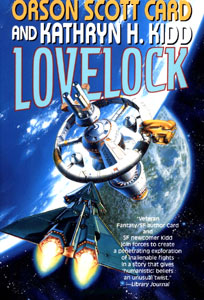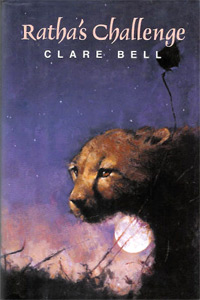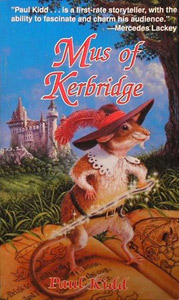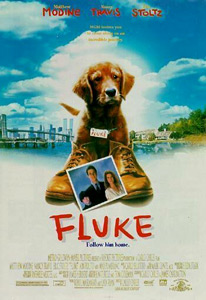
The Yarf! reviews by Fred Patten
Note: This is a fraction of the entire listing. If you’re on broadband, you might want to try the high speed version instead.

The Yarf! reviews by Fred Patten
Note: This is a fraction of the entire listing. If you’re on broadband, you might want to try the high speed version instead.
Welcome to the “Patten’s reviews” wing of the Anthro Library! Since this is a collection of columns from a dormant (if not dead) furzine called YARF!, a word of explanation might be helpful: In its day, YARF! (aka ‘The Journal of Applied Anthropomorphics’) was perhaps the best-known—and best in quality—of furry zines. Started in 1990 by Jeff Ferris, YARF!’s roster of contributors reads like a Who’s Who of furdom in the last decade of the 20th Century. In any issue, the zine’s readers could expect to enjoy work by the likes of Monika Livingstone, Watts Martin, Ken Pick, and Terrie Smith; furry comic strips such as Mark Stanley’s Freefall… and Fred Patten’s reviews of furry books and comics.
Unfortunately, YARF! has been thoroughly inactive since its 69th issue, which was released in September 2003. We can’t say whether YARF! will ever rise again… but at least we can prevent its reviews from falling into disremembered oblivion. And so, with the active cooperation of Mr. Patten, Anthro is proud to present Mr. Patten’s review columns—including the final one, which would have appeared in the never-printed YARF! #70.
Full disclosure: For each reviewed item, we’ve provided links you can use to check which of four different online booksellers—Amazon.com
, Barnes & Noble
, Alibris
, and Powell’s Bookstore—now has it in stock. Presuming the item in question is available, if you buy it Anthro gets a small percentage of the price.
 #36 / May 1995 |
||||
|
|
|
|||
|
|
|
|||
|
|
|
|||
 |
||
| Title: | Lovelock (The Mayflower Trilogy, Book 1) | |
| Author: | Orson Scott Card & Kathryn H. Kidd | |
| Publisher: |
Tor Books (New York) |
|
|
|
||
| ISBN: | 0-312-85732-2 | |
| Hardcover (Jul 1994),285 pages, $21.95, | ||
| Availability: | Am |
|
|
|
||
| ISBN: | 0-812-51805-5 | |
|
Paperback (Apr 1995), xiii + 300 pages, $5.99 |
||
| Availability: | Am |
|
You would never guess that this is a ’morph novel from its astronautical cover by Donato showing a space station orbiting around the earth. But this scene is appropriate for one of the most convincing high-tech scenarios yet written about bioengineered sentient animals.
Lovelock takes place one or two hundred years from now, judging by the sociological and technological changes. The communication highway has become such a speedway that even experts can no longer take in the full scope of data roaring at them. The (apparently global) government has just succeeded in bioengineering mentally-enhanced animals to serve leading scientists and administrators as ‘witnesses’. These monkeys, parrots, miniature pigs, and presumably others, look like ordinary animals but their brains have been nanoelectronically engineered as super data processors. They constantly accompany their important human partners, observing and hearing the same things but recording it far better. Their brains can be connected via electronic jacks to computers for permanent downloading, and for replaying key memories. To better assist their human partners, they have also had their intelligence increased.
Lovelock, the narrator, is an enhanced capuchin monkey, the witness of Dr. Carol Jeanne Cocciolone, a leading gaiologist (a specialist in all aspects of planetary sciences). She is assigned as the head gaiologist aboard humanity’s first interstellar Ark, a pioneering attempt to colonize a habitable planet of another star. To maintain social stability on the decades-long trip, even at near light-speed, and to provide training for the agricultural environment that the humans will need to establish on the new world, the Ark has been designed as an artificial world divided into sixty ‘village’ communities. Colonists have been chosen for their family skills as well as for their technological expertise. Carol Jeanne, her family, and Lovelock are assigned to Mayflower, an old-fashioned New England town.
The novel tells two stories simultaneously. Lovelock, as Carol Jeanne’s constant witness, observes her disintegrating marriage. Her familial bliss is a sham; her household is dominated by her mother-in-law, who has moved in with them. Carol Jeanne is a workaholic who could ignore her ineffectual husband and his manipulative mother as long as she could escape to her office on Earth. But she is too technologically oriented to be at home in the artificial small-town atmosphere with its mandatory ‘morale-maintenance’ social picnics and town gatherings and song fests, where her gossipy mother-in-law soon shines.
Lovelock is aware of the problem. Ordinarily, he would devote himself to helping Carol Jeanne. But his mental conditioning is beginning to wear off. As the story progresses, the focus shifts from Lovelock’s mostly passive reporting of Carol Jeanne’s soap-opera problems, to his own awakening personality and realization of his identity as a sapient individual. It is when he starts using his electronic intelligence to investigate the origins of himself and the whole witness program that the story really comes alive as a s-f thriller.
The ’morph aspects of Lovelock get better as the story advances. A serious challenge to any scientifically plausible story about animals who are the equals of humans is physical reality. Postulating an intelligence-raising drug or mutation that uplifts the intelligence of normal animals to the human level is a pseudoscientific fantasy on the level of faster-than-light travel. It might be possible to raise animals’ intelligence through skillful bioengineering, but why bother? What is the payoff, considering the fantastic research cost that it would take, to have a pig or dog that is as smart as a human? Card and Kidd have found an answer which is unpleasant but plausible.
Since Lovelock is subtitled The Mayflower Trilogy, Book 1, there is clear warning that this novel is not complete in itself. By the end of this volume, the story has become so gripping that the delay until the second volume is published is quite frustrating. You may want to buy this and put it aside until all three volumes are available, but you will want to read it! ![]()
2007 Note: As of this date, Rasputin, the promised Book 2 of this trilogy, has not yet been published, much less Book 3. We readers are still frustrated!
 |
||
| Title: | Ratha’s Challenge | |
| Author: | Clare Bell | |
| Publisher: |
Margaret K. McElderry Books (New York), Jan 1995 |
|
| ISBN: | 0-689-50586-8 | |
|
231 pages, $16.95 |
||
| Availability: | Am |
|
This is the fourth novel in this hardcover Young Adult series; the previous volumes were Ratha’s Creature (1983), Clan Ground (1984), and Ratha and Thistle-Chaser (1990; reviewed in YARF! #7).
A nicely challenging aspect of the novels is that Bell does not provide a pat explanation for every detail. There are clear implications so that the reader may make intelligent assumptions as to what is going on. The continuing story may confirm those assumptions, or it may spring some surprises.
The Named are a clan of intelligent cougar-like great cats living 25,000,000 years ago. Their intelligence is apparently due to a local mutation rather than to slow evolution. Within a few generations, they have worked out a language and a tribal society. They also figured out the advantages of herding deer and other food animals to keep a permanent food supply. However, they are still far outnumbered by their unintelligent cousins, who are attracted by their animals. The Named (so called because each is an individual with a personal name) have to constantly fight to keep their herds from being wiped out by the dumb cats in a feeding frenzy.
The first novel told how Ratha became the leader of the Named by adding fire to their stock of primitive tools. This fourth novel is the most clearly and cleverly science-fictional. The Named come into conflict with a new tribe of cats over control of a herd of wooly mammoths. The new clan acts very intelligently even though its cats do not seem to speak. It soon becomes evident that they have a different form of intelligence: the reader will recognize that they are telepathic, operating through a hive mind controlled by their strong leader, True-of-voice. The separate cats serve as this clan’s eyes; True-of-voice makes the decisions and directs the clan’s entire strength with an instant communication and coordination that the individual warriors of the Named cannot hope to match.
The Named’s previous conflicts have been with cats who only had brute strength and greater numbers. The methods that were developed to fight them are useless against the telepathic hunters. The Named still have their ace-in-the-hole of fire, but Ratha realizes that as soon as the hunters see it, they will be able to figure out how to use it, too. Also, she can generalize from the Named’s own contempt for dumb cats, that the hunters may hold similar feelings without realizing that some cats may be intelligent without being telepathic. Should the Named try to establish friendship with the hunters? But what if the only form of intelligence that they will recognize is as units of their hive-mind? What if calling attention to themselves will only make the Named serious rivals to be eliminated? Ratha has to struggle just to consider the situation objectively, because she is so repelled by the telepaths:
She sighed. “To be frank with you, Thakur, I don’t like these hunters. I like them even less than the witless Un-Named. At least the Un-Named do not enslave themselves willingly to a tyrannical leader, as this True-of-voice seems to be. And they walk around in an endless dream, unable to wake up. It makes me shiver.” (p. 61)
A subplot develops which suggests that there is a distant blood relationship between the two clans, and that the individuality of the Named and the group mind of the hunters may be different aspects of the same mutation. Which is better suited for a feral life-style? In such an environment, with both clans small enough to be barely surviving, can the Named afford the luxury of experimenting with a moral decision; or is the old law of “kill the strangers before they can kill us” the only safe choice? There are several unexpected twists that will keep both Ratha and the reader guessing how to react best to the situation.
In my previous review, I commented that “it is difficult to read these books without being subtly depressed because Ratha’s people are not alive today—i.e., their fight for survival as told in these stories must have ultimately failed.” The jacket blurb of Ratha’s Challenge has a tiny amendment to the statement that the series takes place 25,000,000 years ago; it now says that the setting is an alternate world millions of years ago. Did enough readers complain about the implied extinction of the Named that it was decided to at least hint at a possible survival? I may be cynical, but it seems more likely that there were complaints about scientific inaccuracy—“How dare you teach children that cats were intelligent in the late Miocene epoch?”—and that the change was to defuse them. In any case, Ratha’s Challenge is highly recommended. ![]()
 #37 / Jul 1995 |
||||
|
|
|
|||
|
|
|
|||
|
|
|
|||
 |
||
| Title: | Mus of Kerbridge | |
| Author: | Paul Kidd | |
| Illustrator: | Diesel (map) | |
| Publisher: |
TSR Books (Lake Geneva, WI), Apr 1995 |
|
| ISBN: | 0-7869-0094-6 | |
|
314 pages, $4.95 |
||
| Availability: | Am |
|
This first novel reads like a cross between Brian Jacques, Georgette Heyer, and Rafael Sabatini. If you can imagine a rough parallel of the European wars of the 17th century being fought between intermixed armies of humans and the creatures of faerie, you’ve got the general idea. But there are no anthropomorphic animals—until the creation of Mus, a common mouse sorcerously bioengineered to become a tiny, furry Cavalier knight.
The date is specified as 1641 and 1642, although the geopolitical situation is closer to the 1670s. The names and monarchs are different, but Duncruigh, Nantierre, and Welfland are obviously Britain, France and the United Provinces. When Welfland collapses into violent civil war, the progressive revolutionaries gain support from Duncruigh. This is all that Nantierre’s aggressive young ruler needs to ‘come to the rescue’ of Welfland. As the novel begins, Nantierre is completing the defeat of Duncruigh’s expeditionary army and Welfland’s last revolutionary troops, and the repressive occupation of Welfland in the name of a new puppet king who is no more than a Nantierran viceroy; and is turning Welfland’s large merchant fleet into an armada for the invasion of Duncruigh itself.
But this is a world shared equally by humans, centaurs, satyrs, pixies, and similar creatures of mythology. All are social equals, in a human-based civilization. Think here of Donna Barr’s Stinz series, about rural centaurs living in a late 19th-century or early 20th-century Teutonic society. Some species gravitate toward roles suited to their specialties—the harpies make good aerial scouts and ‘air couriers’, while the centaurs excel as cavalry shock troops—but there appear to be no interspecies prejudices. There are humans, centaurs, etc., etc., among both the nobility and commoners of all nations.
There is also magic. Kerbridge is an old Duncruighan river and university town (Oxford?) whose centaur baron served as commander of the royal armies on the continent. (pg. 7) Nantierre tries to strike at him through his family at Kerbridge Castle. A spy hires Pin-William, an inept satyr sorcerer, to magically get into the castle. He tries to use a mouse as his remote-controlled agent. The brain & body of the natural mouse are too crude, so its mind must be enhanced and its body anthropomorphized to understand and carry out their orders. But the brave mouse, Mus, is strong-willed enough to throw off Pin-William’s control. He saves the baron’s daughter, young Lady Miriam, and the two become firm friends who turn the Nantierrans’ trick back on themselves, using Mus as a tiny spy to uncover enemy agents within the Duncruighan Parliament.
Mus is a delightfully anthropomorphized character. Readers will be amused and enchanted by his adjustment to his altered body and mind, his efforts to fit into the ‘human’ society that is now his, and his exasperated attempts to get people to take him seriously as a wanna-be knight in the king’s service. And Mus finds that he is not the only ’morph, after Pin-William attempts to create new animal puppet-slaves without Mus’ ‘flaws’ of independence.
What about the half-animals? Virtually all other major characters are centaurs or satyrs, with humans, harpies, and others playing only minor roles. Kidd deftly spins a Cavalier-era melodrama full of elegant court intrigue, romance, duels, and knowledgeable 17th-century military action. However, aside from providing colorful decor, there is little need for any characters to be centaurs or satyrs dressed in ruffles and lace. At least Kidd avoids the inconsistencies of less-skilled writers who put half-animals into architecture and clothing designed for humans. The most satisfying scene to take practical note of their physical differences is the Channel naval battle which presages the Nantierran invasion of Duncruigh:
A huge black figure staggered out onto the deck, its hooves skittering for purchase on the wooden planks. Torscha Retter hunched his huge shoulders against a fresh onslaught of spray. A ship is not a natural environment for half-horses, and Torscha’s hooves were hard put to keep purchase on the slippery, rolling deck. He watched in silence as human sailors swarmed nimbly up into the rigging. (pg. 189)
Kidd makes you believe that centaurs can participate in stormy, deck-tossing naval action without falling all over themselves. Mus of Kerbridge is not a comedy, but it certainly blends a sense of humor with its melodrama. It is full of impish, tongue-in-cheek action, led by little Mus who is determined to out-swashbuckle every other knight in Duncruigh. ![]()
 |
||
| Title: | Fluke (movie) | |
| Screenplay: | Carlo Carlei & James Carrington (from the novel by James Herbert) | |
| Cast: | Matthew Modine, Nancy Travis, Eric Stoltz, Max Pomeranc, (voice of) Samuel L. Jackson, Comet (dog), Barney (dog) | |
| Crew: | Carlo Carlei (director); Paul Maslansky, Lata Ryan (producers); Raffaele Mertes (cinematography); Carlo Siliotto (score) | |
|
MGM (2 Jun 1995), 95 minutes |
||
| Availability: | Am / BN / Al / Pw | |
This is an excellent motion-picture version of James Herbert’s 1977 novel Fluke. Fluke is a dog (played by Comet, a golden retriever) who is suddenly aware that he had been a man in a previous life. He becomes obsessed with finding out who he had been, what happened to his family, and how he had died.
This is one of the best live-action movies ever made about animals with human-level intelligence. ‘Talking’ is done telepathically (it was the same in the novel), so there is no problem with phoney-looking lip-sync. The dogs do appear through their body language as though they really are conversing with each other. The only failure is in a brief scene at the very end, where Fluke ‘talks’ with a squirrel. The voice-acting and Comet’s acting are both fine, but it is obvious that the real squirrel is simply not relating to the dog. Doubtlessly due to this problem, Herbert’s novel was revised to remove all other scenes where Fluke ‘talks’ with animals besides dogs. Fluke and Rumbo (the other mutt with a human mind) are hiding the fact that they are not normal canines. This is very intelligently staged; so there is none of the artificiality of Francis the Talking Mule-type comedies where the human cast seems exceptionally stupid not to notice how smart the animals are right behind their backs.
In the novel, most animals are not aware of their previous lives. Fluke’s awareness—and his questioning of why he is an exception—is glossed over with metaphysical patter about how the whole purpose of reincarnation is to improve the soul for Reasons We Do Not Yet Understand. There is doubtlessly Some Divine Purpose for Fluke to have access to his human memories. At least Herbert had the imagination to avoid the cliché of ‘coming back to complete unfinished business because of an untimely death’. There are thousands of humans killed every day in ‘untimely deaths’; if that were true, there should be so many reincarnated animals trying to contact their ‘loved ones’ that it would have been obvious long ago. No, Fluke must have his human memory for some other unknown reason. This seems like a huge cop-out, but Herbert deserved credit for knowing that a metaphysical cop-out was better than a completely unconvincing rational excuse.
The movie has its own rules of reincarnation. Any mentions of ‘souls’ or of ascending to a higher plane are severely downplayed. Fluke learns that when ‘people’ are reborn as something else, they are to accept this as the natural order of things. They must live the normal life of whatever creature they now are, instead of trying to go back to continue a previous life in their new body. Two scenes make the point that ‘people’ do not forget past lives. All animals are as smart and aware of their human pasts as Fluke is—they simply are ‘hiding it’ as they are meant to do.
This premise is consistent within the scope of the movie, but it raises some different credibility problems. Presumably one should not wonder about such questions as why cattle or pigs would go so docilely to slaughterhouses if they know what to expect there. Is it only a coincidence that this is so consistent with the ‘Circle of Life’ philosophy in The Lion King, where the herbivores apparently do not mind that their lion monarchs will eat them because it is ‘the natural order’? This switch cancels any questions of why Fluke has ‘come back’ or why, if they all come back, only he is aware of it. However, it creates the opposite question of why Fluke is apparently the only animal who needs to have this explained to him. When he asks Rumbo if he remembers his past life, Rumbo clumsily changes the subject with an embarrassed ‘we don’t talk about such things in public’ attitude. If the subject is not taught to newborn animals (like sex education to American children?), then why doesn’t Fluke know it instinctively like the other animals?
One problem in both the novel and the movie is with Jeff, the man who had been Fluke’s business partner in his previous life as Tom (Matthew Modine). Fluke does not know whether Jeff (Eric Stoltz) was really his loyal friend or his murderer. It is even more obvious here than on the printed pages that, like Jessica Rabbit in Who Framed Roger Rabbit, the audience is supposed to be kept guessing until the climax. As a result, Stoltz must play the role in an unnaturally emotionless manner, not giving any clues as to whether he is genuinely friendly or just faking it, until the denouement, after which he suddenly displays appropriate normal emotions. It is annoyingly clear that the author/director is jerking the reader/moviegoer around.
There are several cosmetic changes between the novel and the film. In addition to switching the rules of reincarnation, the locale is changed from England to the American South. Nigel and Reg become the more American-sounding Tom and Jeff, and Nigel’s daughter Polly becomes son Brian. But on all significant points, the film is much more faithful in mood and in basic plot than most movie adaptations are to their original stories.
Fluke is not a perfect movie, but its good points outweigh its problems. Frankly, even if it were a real ‘dog’ (which it is not), it might be worth supporting with your admission or your video rental, to help show that the public is ready for serious dramas about talking animals. If Fluke is not a success, there may not be any more talking-animal movies except The Shaggy Dog-level comedies for a long time to come. ![]()
|
|